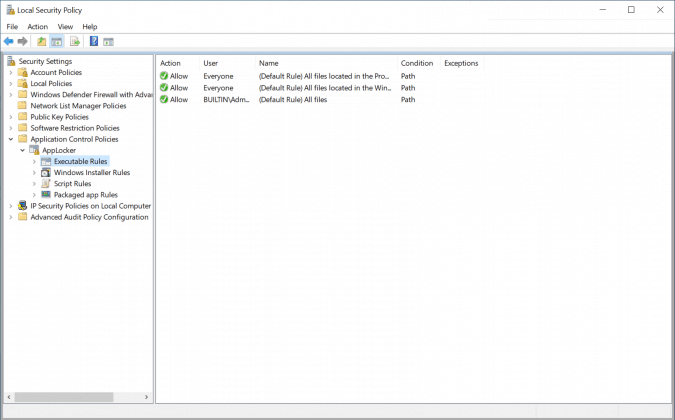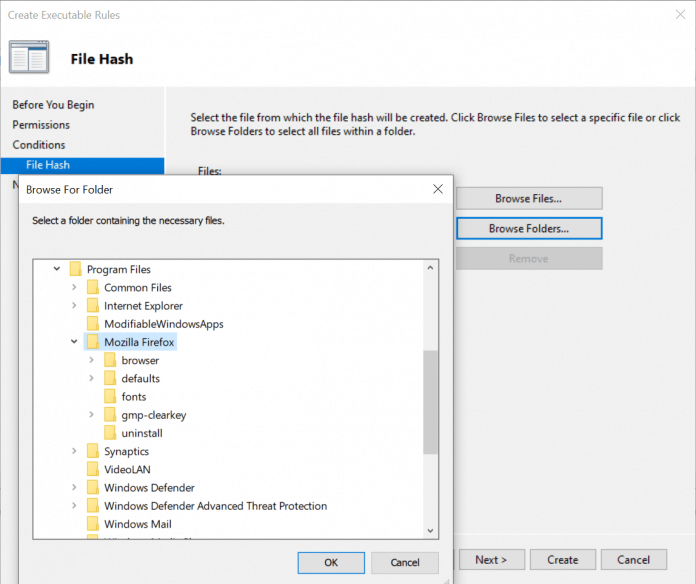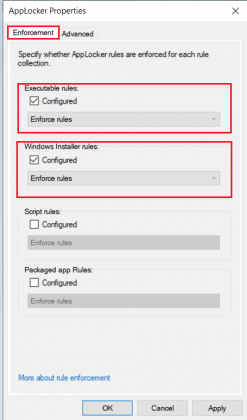
Malware authors take advantage of this and other writable areas within the operating system to load and execute their malware. The default NTFS permissions grant a user Read/Write permission to their workspace, as well as all "Authenticated Users" have Read/Write permissions to %WinDir%/Temp (see diagram below). So when a rule is defined to allow "Everyone" to execute all files located in the %WinDir% folder an exception should be made to block applications used to managed the operating system (Registry Editor for example).

Exceptions are an important part of the rules a non-admin shouldn't need to modify system files or the registry. Along with the Whitelist rules, exceptions can be defined to prevent certain files from being executed from the initial larger rule set.

You can also create rules from a hash of the file or a path to a set of files. AppLocker allows an administrator to define a set of rules to be applied against non-admins, which can be based on attributes from a file's digital signature including the Publisher, Product or Version.
#APPLOCKER POLICY UPDATE#
AppLocker is an update from Software Restriction Policies feature (XP/2003) that was released with Windows 7/Server 2008 R2. For a complete list of version availability, see here. AppLocker has always been available for all versions of Windows Server, with the exception of Server Core. Initially AppLocker was only available on enterprise level desktop versions but, starting with Windows 10, it is now available for both Enterprise and Education versions. Microsoft provides a built-in tool named AppLocker. One of the recommended steps is to run a Whitelisting tool. To protect your enterprise, there are many steps for a Defense in Depth strategy to be taken. If people don't understand the risk, changes won't be made. There have been several high profile attacks in the press over the past few months and Understanding the Risk is important. Ransomware has been getting a lot of attention. Hello, Paul Bergson here with a discussion on Security in particular utilizing Microsoft's AppLocker to help prevent the infection of Malware. The MSI installation for the user now completed without any problems.First published on TechNet on Jun 27, 2016 Icacls C:\Windows\ccmcache /grant "Users":(OI)(CI)R /inheritance:r In order to change that, I ran the following command.
#APPLOCKER POLICY INSTALL#
The problem was when I choose Install for user in the Deployment properties, the logged on user didn’t have read rights on C:\Windows\ccmcache and recursive folders. In this case the problem was clearly not an AppLocker policy, since the PolicyDecision shows Allowed. Get-AppLockerPolicy -Effective | Test-AppLockerPolicy -Path 'C:\Windows\ccmcache\t\file.msi' | flįilePath : C:\Windows\ccmcache\t\file.msi Open up a PowerShell prompt as the user you want to verify AppLocker rules for, you could shift + right-click on the PowerShell icon in order to Run as another user.

My instinct lead me to believe that there were some AppLocker policy blocking the installation. Here’s an easy PowerShell command to test just that. The installation of is not permitted due to an error in software restriction policy processing.
#APPLOCKER POLICY CODE#
Today I ran into a problem where a custom MSI package would’nt install and exited with error code 1625. If you’re using AppLocker in your Windows 7 environment as I’m, you sometimes maybe want to verify that AppLocker is not the culprit.


 0 kommentar(er)
0 kommentar(er)
